

An introduction to MVC frameworks. Web development has changed significantly in the past few years; it hasn’t been long since deploying a web project simply involved uploading static HTML, CSS and JavaScript files to a HTTP server.
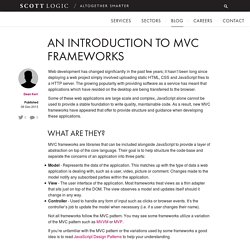
The growing popularity with providing software as a service has meant that applications which have resided on the desktop are being transferred to the browser. Some of these web applications are large scale and complex, JavaScript alone cannot be used to provide a stable foundation to write quality, maintainable code. Build-a-javascript-framework. Javascript MV* Frameworks Like Angular.js and Backbone.js. Javascript frameworks take the ideas of templating, e.g. moving logic from your server to the client, to the next level.
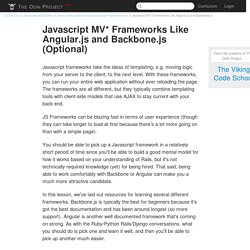
With these frameworks, you can run your entire web application without ever reloading the page. The frameworks are all different, but they typically combine templating tools with client-side models that use AJAX to stay current with your back end. JS Frameworks can be blazing fast in terms of user experience (though they can take longer to load at first because there's a lot more going on than with a simple page). You should be able to pick up a Javascript framework in a relatively short period of time since you'll be able to build a good mental model for how it works based on your understanding of Rails, but it's not technically required knowledge (yet) for being hired. Backbone.js Wine Cellar Tutorial — Part 1: Getting Started.
One of the challenges when building nontrivial Web applications is that JavaScript’s non-directive nature can initially lead to a lack of structure in your code, or in other words, a lack of… backbone.

JavaScript is often written as a litany of free-hanging and unrelated blocks of code, and it doesn’t take long before it becomes hard to make sense of the logic and organization of your own code. Backbone.js is a lightweight framework that addresses this issue by adding structure to JavaScript-heavy Web applications.Self-contained building blocks Backbone.js provides several classes (Model, Collection, View, Router) that you can extend to define the building blocks of your application. To build an app with Backbone.js, you first create the Models, Collections, and Views of your application. You then bring these components to life by defining a “Router” that provides the entry points of your application through a set of (deep-linkable) URLs. Data Binding Elegant REST Integration Download. Rich JavaScript Applications – the Seven Frameworks (Throne of JS, 2012)
It’s no longer good enough to build web apps around full page loads and then “progressively enhance” them to behave more dynamically.
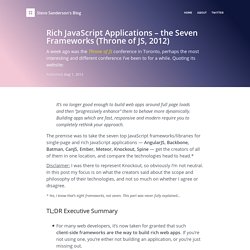
Building apps which are fast, responsive and modern require you to completely rethink your approach. The premise was to take the seven top JavaScript frameworks/libraries for single-page and rich JavaScript applications — AngularJS, Backbone, Batman, CanJS, Ember, Meteor, Knockout, Spine — get the creators of all of them in one location, and compare the technologies head to head.* Disclaimer: I was there to represent Knockout, so obviously I’m not neutral. . * Yes, I know that’s eight frameworks, not seven. TL;DR Executive Summary For many web developers, it’s now taken for granted that such client-side frameworks are the way to build rich web apps. Backbone.js Tips And Patterns. Advertisement Backbone.js1 is a popular open-source JavaScript “MV*” framework that has gained significant traction since its first release a little over three years ago.
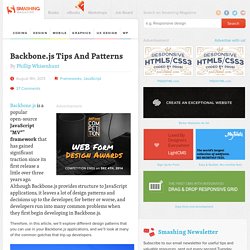
Although Backbone.js provides structure to JavaScript applications, it leaves a lot of design patterns and decisions up to the developer, for better or worse, and developers run into many common problems when they first begin developing in Backbone.js. Therefore, in this article, we’ll explore different design patterns that you can use in your Backbone.js applications, and we’ll look at many of the common gotchas that trip up developers. 2Applications, like buildings, are best built following known patterns. (Image: Matthew Rutledge3) Perform Deep Copies Of Objects. Backbone.js Tutorials. Journey Through The JavaScript MVC Jungle - Smashing Magazine.
Advertisement When writing a Web application from scratch, it’s easy to feel like we can get by simply by relying on a DOM1 manipulation library (like jQuery412) and a handful of utility plugins.

The problem with this is that it doesn’t take long to get lost in a nested pile of jQuery callbacks and DOM elements without any real structure in place for our applications. In short, we’re stuck with spaghetti code3. Fortunately there are modern JavaScript frameworks that can assist with bringing structure and organization to our projects, improving how easily maintainable they are in the long-run. What Is MVC, Or Rather MV*? These modern frameworks provide developers an easy path to organizing their code using variations of a pattern known as MVC4 (Model-View-Controller).
Models represent the domain-specific knowledge and data in an application. JavaScript ‘MVC’ frameworks that can help us structure our code don’t always strictly follow the above pattern. Why is Dojo not the dominant toolkit? Underscore.js. An Introduction to Backbone.js. Backbone.js for Absolute Beginners - Getting Started (Part 1: Intro) - Adrian Mejia’s Blog.
Backbone.js is a JavaScript framework, among many others, that is gaining special attention in the web development community because it’s ease of use and the structure that it provides to JavaScript applications.

(Updated: 2013-02-02, 2013-11-24) Brief Background (optional reading) An Intro to Backbone.js: Part 1 – Models and Collections - Liquid Media. This is Part 1 of a series of tutorials.
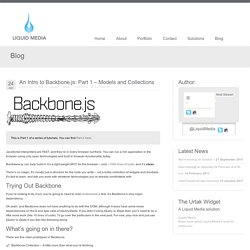
You can find Part 2 here. JavaScript interpreters are FAST, and they’re in every browser out there. You can run a rich application in the browser using only open technologies and built in browser-functionality, today. A Thorough Introduction To Backbone.Marionette (Part 3) Advertisement To help you tap the full potential of Marionette, we’ve prepared an entire eBook1 full of useful hands-on examples which is also available in the Smashing Library2. — Ed.
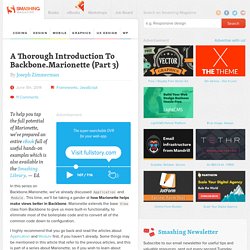
In this series on Backbone.Marionette, we’ve already discussed Application and Module. This time, we’ll be taking a gander at how Marionette helps make views better in Backbone. Marionette extends the base View class from Backbone to give us more built-in functionality, to eliminate most of the boilerplate code and to convert all of the common code down to configuration. I highly recommend that you go back and read the articles about Application3 and Module4 first, if you haven’t already. Event Binding Up until recently, Backbone views were often mishandled, causing a horrible problem known as “zombie views.” Many Backbone extensions and plugins — including Marionette — remedied this early on. This accomplishes the same thing as using listenTo, except it requires less code. A Thorough Introduction To Backbone.Marionette (Part 3) Backbone.js Tutorials. Introduction to Backbone.js. Introduction The web application development process has been evolving over the years.
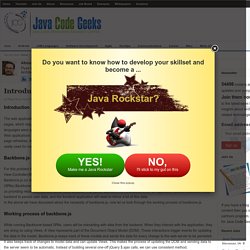
In the beginning web applications were just static HTML pages, which required programmers to change the code in order to change the content. Later, in web 2.0, server side programming languages were added to generate HTML pages dynamically based on user input and data stored in database. Web applications nowadays require heavy use of JavaScript to generate content on the fly.
The user needn’t wait between requests and page refreshes. BackBone Tutorial – Part 1: Introduction to Backbone.Js. Introduction In this article we will try to look at the basics of Javascript frameworks an try to introduce backbone.js Background Link to complete series: It was a long time ago (almost a decade back) when most software applications were getting built as standalone applications. These applications were targeted at a single user and ran on their operating systems. The major differentiating factor for these two applications was that the distributed applications provided an interactive user experience whereas web applications provided very limited features (due to technology limitations). An Introduction to Backbone.js. Last week I gave a presentation on Backbone.js to the rest of the developers here at Clock. The amount of exposure we've had to client side heavy-lifting varies, so the idea was to get everyone on the same page.
The other guys found it pretty handy, so I thought I'd write it up here where there's a chance it could be useful to others. The Basics of Object-Oriented JavaScript. Over recent years, JavaScript has increasingly gained popularity, partly due to libraries that are developed to make JavaScript apps/effects easier to create for those who may not have fully grasped the core language yet. While in the past it was a common argument that JavaScript was a basic language and was very 'slap dash' with no real foundation; this is no longer the case, especially with the introduction of high scale web applications and 'adaptations' such as JSON (JavaScript Object Notation).
JavaScript can have all that an Object-Orientated language has to offer, albeit with some extra effort outside of the scope of this article. Congratulations, you just created an object. There are two ways to create a JavaScript object: they are 'Constructor functions' and 'Literal notation'. The one above is a Constructor function, I'll explain what the difference is shortly, but before I do, here is what an Object definition looks like using literal notation. So which one should you use? Introduction to Object-Oriented JavaScript. Object-oriented to the core, JavaScript features powerful, flexible OOP capabilities. This article starts with an introduction to object-oriented programming, then reviews the JavaScript object model, and finally demonstrates concepts of object-oriented programming in JavaScript.
This article does not describe the newer syntax for object-oriented programming in ECMAScript 6. JavaScript review If you don't feel confident about JavaScript concepts such as variables, types, functions, and scope, you can read about those topics in A re-introduction to JavaScript. OOP In JavaScript: What You NEED to Know. (Object Oriented JavaScript: Only Two Techniques Matter) Prerequisite:JavaScript Objects in DetailJavaScript Prototype Object Oriented Programming (OOP) refers to using self-contained pieces of code to develop applications.
We call these self-contained pieces of code objects, better known as Classes in most OOP programming languages and Functions in JavaScript. Prototypal Inheritance. Understanding “Prototypes” in JavaScript. For the purposes of this post, I will be talking about JavaScript objects using syntax defined in ECMAScript 5.1. The basic semantics existed in Edition 3, but they were not well exposed. In JavaScript, objects are pairs of keys and values (in Ruby, this structure is called a Hash; in Python, it's called a dictionary). For example, if I wanted to describe my name, I could have an object with two keys: firstName would point to "Yehuda" and lastName would point to "Katz".